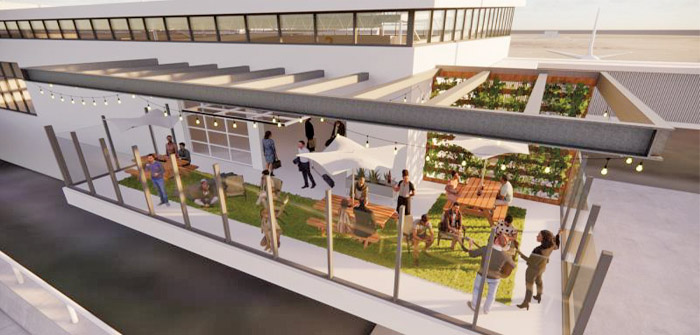(Rendering courtesy of Redmond Municipal Airport)
Rejoice, those who depend on the Redmond Municipal Airport (RDM) for flights in and out of Central Oregon, as plans are underway for a “massive expansion,” in the words of Zachary Bass, director, to double the size of the terminal, and “expand and update basically everything to make it bigger and better.”
Currently ranking #100 in size among U.S. airports, RDM has handled increasing numbers of passengers since the first commercial flight by United took off back in 1946. Passenger count totaled 200k annually in 1997, and 460k by 2009 — resulting in a major airport expansion, When Bass started at RDM eight years ago, the number of annual passengers had gone up to 700,000, and now stands at 1.25 million — “which is way ahead of growth projections,” he said.
As a result, there simply isn’t enough space — with congestion affecting everything from security lines to seating at the gates, baggage claim, bathrooms, and food and retail concessions. The major “pain point,” according to Bass, is the holding (or waiting) area — most dramatically during the airport’s busiest 6-8am period when 11 flights arrive and depart. “At some point, we can’t put more people in a building,” Bass has said.
The first phase of the expansion will get underway this fall and take two years to complete at a cost of $100M. It includes completely redesigning the second floor, adding 50,000 square feet, and constructing six or seven jet bridges to reduce the number of flights boarded outdoors on the tarmac. Funding will come from airport savings and federal grants; no city taxes are involved, said Bass.
Phases two through five will expand and reconfigure the ticket and baggage claim areas, control tower, east side departure lounge, and administration offices. Completion of all five phases is contingent on acquisition of funding, including the airport’s own revenue, a variety of state and federal grants (for which, Bass admitted, there is “intense competition”), the 2022 Bipartisan Infrastructure Law that set aside more than $2 billion for U.S. airports, and a possible revenue bond.
Also envisioned upon completion of all five phases are roughly 12 additional gates that will, Bass hopes, motivate airlines to augment their schedules with more connections. (He characterized the most recent example, Alaska Airlines’ new direct flight to Las Vegas, as “doing gangbusters.”)
Local officials are unanimous in crediting RDM’s major role in the area’s economic development. Redmond City Manager Keith Witcosky compared its importance to “the Deschutes River or the Cascade Mountains when it comes to determining the success of Central Oregon,” while Jon Stark, EDCO’s chief executive officer, has been quoted as saying “without it, we’re an island.”
These sentiments are buttressed by a State of Oregon economic impact report that projects the full expansion at RDM will add 207 jobs and bring in $39 million a year to the area.
Calling himself “a cheerleader for the airport,” Bass — who “has “always been around aviation” and admits that “I don’t do well standing still” — is well equipped to face the challenges that lie ahead for his 40-employee team. And given “great support from the city council and the region” for the ambitious expansion plans, one of the busiest commercial airports in the entire Northwest is well on its way to become “bigger and better.”





